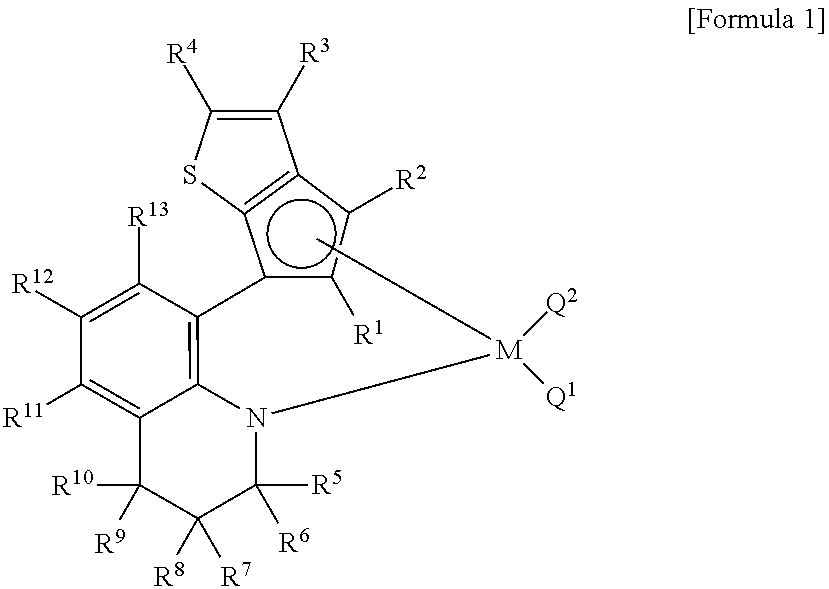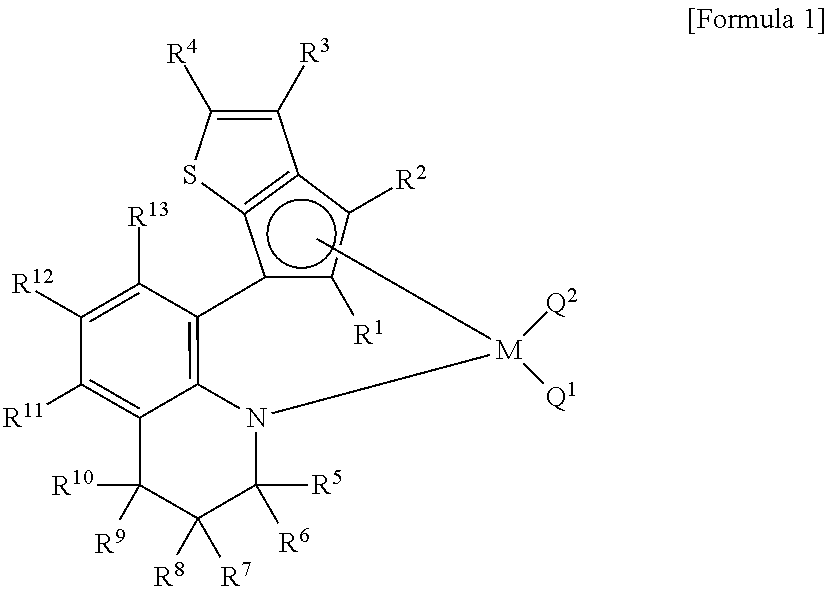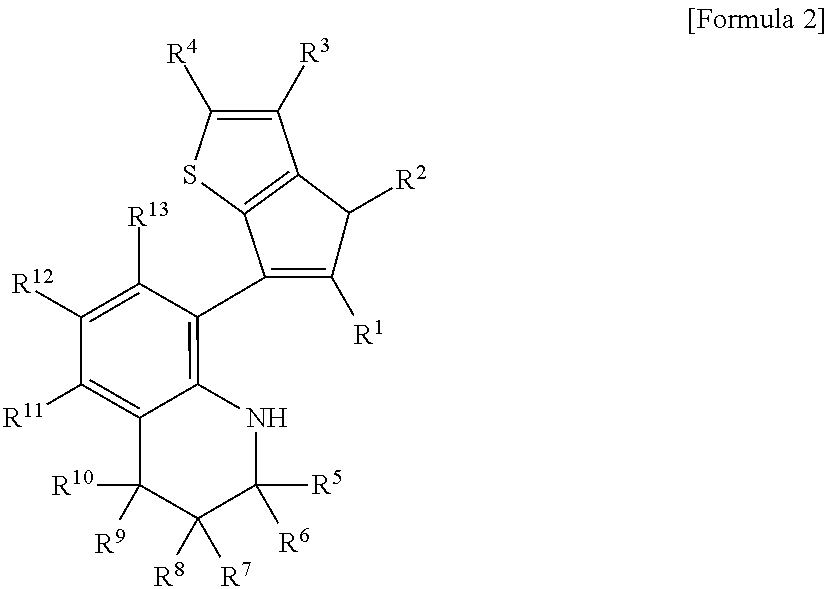Method for preparing polypropylene using transition metal compound containing thiophene-fused cyclopentadienyl ligand
a technology of cyclopentadienyl ligand and transition metal compound, which is applied in the field of polypropylene preparation using thiophenefused cyclopentadienyl ligand, can solve the problems of undeveloped app in terms of commercial use, inability of improved isotacticity process to yield amorphous app, and inability to use ipp process with improved isotacticity, etc., to achieve easy control of fine fin
- Summary
- Abstract
- Description
- Claims
- Application Information
AI Technical Summary
Benefits of technology
Problems solved by technology
Method used
Image
Examples
example i-1
Synthesis of Precursor D-1
[0099]A Schlenk flask containing 1,2,3,4-tetrahydroquinoline (1.00 g, 7.51 mmol) and diethyl ether (16 ml) was cooled down in a cold bath at −78° C. and stirred while n-butyl lithium (3.0 mL, 7.5 mmol, 2.5 M hexane solution) was slowly added under the nitrogen atmosphere. After one-hour agitation at −78° C., the flask was gradually warmed up to the room temperature. A light yellowish solid precipitated, and the butane gas was removed through a bubbler. The flask was cooled down back to −78° C. and supplied with carbon dioxide. Upon injection of carbon dioxide, the slurry-type solution turned to a clear homogenous solution. After one-hour agitation at −78° C., the flask was gradually warmed up −20° C. while the extra carbon dioxide was removed through the bubbler to remain a white solid as a precipitate.
[0100]Tetrahydrofuran (0.60 g, 8.3 mmol) and t-butyl lithium (4.9 mL, 8.3 mmol, 1.7 M pentane solution) were sequentially added at −20° C. in the nitrogen at...
example i-2
Synthesis of Precursor D-2
[0104]The procedures were performed in the same manner as described in the synthesis of the compound D-1 in Example i-1, excepting that the compound C-2 was used rather than the compound C-1, to yield a precursor compound D-2. The yield was 53%.
[0105]In the 1H NMR spectrum of the final product, there was observed a set of two signals at ratio of 1:1, resulting from the difficulty of rotating about the carbon-carbon bond (marked as a thick line in the Scheme 2) between phenylene and cyclopentadiene.
[0106]1H NMR (C6D6): δ 7.23 (d, J=7.2 Hz, 1H), 6.93 (d, J=7.2 Hz, 1H), 6.74 (br t, J=7.2 Hz, 1H), 4.00 and 3.93 (s, 1H, NH), 3.05 (br q, J=8.0 Hz, 1H, CHMe), 3.00-2.80 (br, 2H, CH2), 2.70-2.50 (br, 2H, CH2), 2.16 (s, 3H, CH3), 2.04 (br s, 3H, CH3), 1.91 (s, 3H, CH3), 1.75-1.50 (m, 2H, CH2), 1.21 (d, J=8.0 Hz, 3H, CH3) ppm.
[0107]13C NMR (C6D6): 151.60 (151.43), 145.56 (145.36), 143.08, 141.43, 132.90, 132.68, 132.43, 129.70, 121.63, 120.01, 116.77, 46.13, 42.58, 28...
example i-3
Synthesis of Precursor D-3
[0108]The procedures were performed in the same manner as described in the synthesis of the compound D-1 in Example i-1, excepting that tetrahydroquinaline was used rather than tetrahydroquinoline, to yield a precursor compound D-3. The yield was 63%.
[0109]In the 1H NMR spectrum of the final product, a certain signal was split into a set of four signals at ratio of 1:1:1:1, resulting from the difficulty of rotating about the carbon-carbon bond (marked as a thick line in the Scheme 2) between phenylene and cyclopentadiene and isomerism pertaining to the existence of two chiral centers.
[0110]1H NMR (C6D6): δ 7.33, 7.29, 7.22, and 7.17 (d, J=7.2 Hz, 1H), 6.97 (d, J=7.2 Hz, 1H), 6.88 (s, 2H), 6.80-6.70 (m, 1H), 3.93 and 3.86 (s, 1H, NH), 3.20-2.90 (m, 2H, NCHMe, CHMe), 2.90-2.50 (m, 2H, CH2), 1.91, 1.89, and 1.86 (s, 3H, CH3), 1.67-1.50 (m, 1H, CH2), 1.50-1.33 (m, 1H, CH2), 1.18, 1.16, and 1.14 (s, 3H, CH3), 0.86, 0.85, and 0.80 (d, J=8.0 Hz, 3H, CH3) ppm.
[0111...
PUM
| Property | Measurement | Unit |
|---|---|---|
| temperature | aaaaa | aaaaa |
| molar ratio | aaaaa | aaaaa |
| mechanical properties | aaaaa | aaaaa |
Abstract
Description
Claims
Application Information
 Login to View More
Login to View More - R&D
- Intellectual Property
- Life Sciences
- Materials
- Tech Scout
- Unparalleled Data Quality
- Higher Quality Content
- 60% Fewer Hallucinations
Browse by: Latest US Patents, China's latest patents, Technical Efficacy Thesaurus, Application Domain, Technology Topic, Popular Technical Reports.
© 2025 PatSnap. All rights reserved.Legal|Privacy policy|Modern Slavery Act Transparency Statement|Sitemap|About US| Contact US: help@patsnap.com



